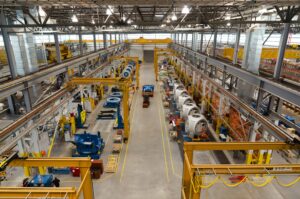It is well known how COVID-19 has accelerated the digital transformation for companies. While the shift was expected, not many would have guessed that it would happen so quickly, and the adoption would cut across industries. IoT has had its own share of tail winds. In this piece, Alok Bardiya, Head – IoT (Business Unit), Tata Communications discusses how IoT is becoming a priority for businesses looking for scalability and speed.
Organisations are not simply looking to sail through the pandemic with an aim of returning to whatever their version of normal was and the changes they have implemented now are shaping a new future. As enterprises are getting their manpower back to the workplace, smarter digital workplace technologies, such as connected worker solutions including contact tracing, contactless operations, remote monitoring and more, have come to the forefront. Decisions about IoT adoption that were earlier on the back burner and viewed more as small, isolated projects – are now being prioritised and pulled forward. But the question is can it be scaled faster and made easier to implement?
Cloud-ifying IoT
Two of the top tech trends of the last decade – Cloud and Software-as-a-Service (SaaS) – grew on the back of the flexibility and scalability that they brought. It empowered the tech teams and the users in a big way by allowing them to spin a virtual machine on the fly or add users to a SaaS application remotely and immediately. These two reached a recent high by enabling real-time collaboration between the dispersed co-workers and extending entertainment to masses stuck at home.
brought. It empowered the tech teams and the users in a big way by allowing them to spin a virtual machine on the fly or add users to a SaaS application remotely and immediately. These two reached a recent high by enabling real-time collaboration between the dispersed co-workers and extending entertainment to masses stuck at home.
In a parallel world, IoT has the same or perhaps even more potential. It is applicable to any sector or any process. Today, enterprises are expanding their IoT focus and going beyond just the assembly line. They are looking at a much broader canvas – from remote operations to worker safety and management to delivering broader more efficiencies in what one can call as man-machine-material interfaces.
The first pillar – Think in terms of an “IoT fabric”
A full IoT solution is a combination of multiple components – sensors, devices, communications, cloud and software. So, can IoT be Cloudified? Some aspects of SaaS like agility can still be brought in but for that an enterprise will need to think of “shrink wrapping” some of these components into a “unified core”.
“Just like an IoT fabric running across the enterprise and turning the rest into flexible add on – like lego blocks, to build new use cases. This IoT fabric should have the ability to take any device and ability to self-create new dashboards, reports, and analytics on the fly.”
Depending on the use case, enterprises can change a module to turn a device from measuring temperature to pressure to weight or any other parameter – the choice is theirs and determined by what they want to drive. They can empower different functions or teams within the enterprise to use this fabric to create their own IoT use cases. For instance, if campus facilities want to monitor trash bins or whether doors are open or closed, or simply check attendance in the cafeteria, appropriate sensors can help track and visualise this data as a dashboard in the platform. Specific rules can also be defined, trends analysed and alerts triggered, thus ensuring better efficiencies.

A large manufacturing company is using this ‘fabric’ approach to add multiple use cases as they go along. Starting with lights management, they have now added monitoring gases and even dust sensing in their factory environment. The company is using the same fabric for worker safety and efficiency use cases as well. Even as the manufacturing company implemented worker solution, they realised that it can be extended to materials management and how vendor deliveries can be managed more efficiently. As a result, the enterprise is targeting gains of upto 10% in productivity and turnaround times.
“It’s not just Enterprises – with initiatives like Smart Cities and Digital India, the penetration of IoT technologies is broader and the same IoT fabric is improving infrastructure, public utilities and services. An IoT enabled streetlight can also be enabled to measure air quality or temperature or rainfall.”
The second pillar of flexibility – ecosystem and OPEX based business model
Cloud and SaaS enabled a partner ecosystem, with partners playing a big role. SFDC used force.com to offer a lot more applications to the customer. Similarly, partners are playing a significant role in the IoT setup by providing standardised blocks that organisations can deploy on a plug and play model to their IoT fabric. Service providers and others are already offering this plug and play approach. A few others are working on similar universal adapter modules that will turn any device into a smart device.
“Success of cloud and SaaS were also driven by OPEX based and freemium pricing models that attracted tons of users. IoT will also require similar thinking, where vendors and customers share upfront costs, drive down CAPEX investments, and link payments to specific outcomes or efficiencies gained”
Conclusion
As we go forward, enterprises will continue to rely on IoT to recover and thrive in the post-COVID-19 scenario. IoT’s cloud moment is going to be about empowering users to create their own solutions. It will be about taking the complexity out and allowing for a flexible amalgamation of a common fabric, vendor partners and new business models.
Discover more about how IoT can transform your business in a post-covid world.
Transformational Hybrid SolutionsOur cloud-enablement services offer the best performance on your traffic-heavy websites or mission-critical applications.
Core NetworksTata Communications™ global IT infrastructure and fibre network delivers the resources you need, when and where you need them.
Network Resources
Unified Communications As A ServiceBreak the barriers of borders efficiently and increase productivity with Tata Communications’ UC&C solutions.
Global SIP ConnectEmpower your business with our SIP network and witness it grow exponentially.
InstaCC™ - Contact Centre As A ServiceCloud contact centre solutions for digital customers experience and agent productivity.
Unified Communication Resources Case studies, industry papers and other interesting content to help you explore our unified communications solution better.
IoT SolutionsThe Internet of Things is transforming the way we experience the world around us for good. Find out more about our Internet Of Things related solutions here.
Mobility SolutionsTata Communications’ mobility services enable your enterprise to maintain seamless communication across borders, with complete visibility of cost and usage.
Mobility & IoT Resources
Multi-Cloud SolutionsWith enterprises transitioning to a hybrid multi-cloud infrastructure, getting the right deployment model that yields ROI can be a daunting task.
Cloud ComplianceCompliant with data privacy standards across different countries and is also designed to protect customers’ privacy at all levels.
IZO™ Cloud Platform & ServicesIZO™ is a flexible, one-stop cloud enablement platform designed to help you navigate complexity for more agile business performance.
Managed Infrastructure ServicesIntegrated with our integrated Tier-1 network to help your business grow efficiently across borders.
Cloud PartnersWe support a global ecosystem for seamless, secure connectivity to multiple solutions through a single provider.
Cloud Resources
Governance, Risk, and ComplianceRisk and Threat management services to reduce security thefts across your business and improve overall efficiencies and costs.
Cloud SecurityBest-in-class security by our global secure web gateway helps provide visibility and control of users inside and outside the office.
Threat Management - SOCIndustry-leading threat-management service to minimise risk, with an efficient global solution against emerging security breaches and attacks.
Advanced Network SecurityManaged security services for a predictive and proactive range of solutions, driving visibility and context to prevent attacks.
Cyber Security ResourcesCase studies, industry papers and other interesting content to help you explore our securtiy solution better.
Hosted & Managed ServicesTata Communications provide new models for efficient wholesale carrier voice service management. With our managed hosting services make your voice business more efficient and better protected
Wholesale Voice Transport & Termination ServicesYour long-distance international voice traffic is in good hands. End-to-end, voice access & carrier services which includes voice transport and termination with a trusted, global partner.
Voice Access ServicesTata Communication’s provide solutions which take care of your carrier & voice services, from conferencing to call centre or business support applications.
Carrier Services Resources
CDN Acceleration ServicesOur CDN Web Site Acceleration (WSA) solution helps deliver static and dynamic content, guaranteeing higher performance for your website.
CDN SecuritySafeguard your website data and customers’ information by securing your website from hacks and other mala fide cyber activities.
Video CDNDeliver high-quality video content to your customers across platforms – website, app and OTT delivery.
CDN Resources
Elevate CXIncrease customer satisfaction while empowering your service team to deliver world-class customer experience and engagement.
Live Event ServicesTata Communications’ live event services help battle the share if eyeballs as on-demand video drives an explosion of diverse content available on tap for a global audience.
Media Cloud Infrastructure ServicesTata Communications’ media cloud infrastructure offers flexible storage & compute services to build custom media applications.
Global Media NetworkTata Communications’ global media network combines our expertise as a global tier-1 connectivity provider with our end-to-end media ecosystem.
Use CasesUse cases of Tata Communications’ Media Entertainment Services
Remote Production SolutionsMedia contribution, preparation and distribution are highly capital-intensive for producers of live TV and video content, and their workflows are complex.
Media Cloud Ecosystem SolutionsThe Tata Communications media cloud infrastructure services offer the basic building blocks for a cloud infrastructure-as-a-service.
Global Contribution & Distribution SolutionsTata Communications’ global contribution and distribution solution is built to reduce capital outlay and grow global footprint.
Satellite Alternative SolutionsAs more and more consumers choose to cut the cord & switch to internet-based entertainment options, broadcasters are faced with capital allocation decisions.
LeadershipA look into the pillars of Tata communications who carry the torch and are living embodiment of Tata’s values and ethos.
Culture & DiversityHere at Tata Communications we are committed to creating a culture of openness, curiosity and learning. We also believe in driving an extra mile to recognize new talent and cultivate skills.
OfficesA list of Tata Communications office locations worldwide.
FAQCheck out our FAQs section for more information.
SustainabilityOur holistic sustainability strategy is grounded in the pillars of People, Planet and Community with corporate governance at the heart of it.
BoardHave a look at our board of members.
ResultsFind out more about our quarterly results.
Investor PresentationsFollow our repository of investor presentations.
FilingsGet all information regarding filings of Tata communications in one place.
Investor EventsAll investor related event schedule and information at one place.
GovernanceAt Tata, we believe in following our corporate social responsibility which is why we have set up a team for corporate governance.
SharesGet a better understanding of our shares, dividends etc.
SupportGet all investor related contact information here.

